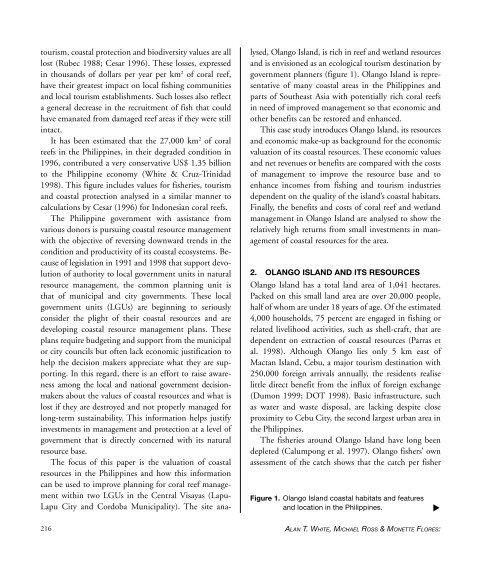Create successful ePaper yourself
Turn your PDF publications into a flip-book with our unique Google optimized e-Paper software.
▲<br />
tourism, coastal protection and biodiversity values are all<br />
lost (Rubec 1988; Cesar 1996). These losses, expressed<br />
in thousands <strong>of</strong> dollars per year per km 2 <strong>of</strong> coral reef,<br />
have their greatest impact on local fishing communities<br />
and local tourism establishments. Such losses also reflect<br />
a general decrease in the recruitment <strong>of</strong> fish that could<br />
have emanated from damaged reef areas if they were still<br />
intact.<br />
It has been estimated that the 27,000 km 2 <strong>of</strong> coral<br />
reefs in the Philippines, in their degraded condition in<br />
1996, contributed a very conservative US$ 1.35 billion<br />
to the Philippine economy (White & Cruz-Trinidad<br />
1998). This figure includes values for fisheries, tourism<br />
and coastal protection analysed in a similar manner to<br />
calculations by Cesar (1996) for Indonesian coral reefs.<br />
The Philippine government with assistance from<br />
various donors is pursuing coastal resource management<br />
with the objective <strong>of</strong> reversing downward trends in the<br />
condition and productivity <strong>of</strong> its coastal ecosystems. Because<br />
<strong>of</strong> legislation in 1991 and 1998 that support devolution<br />
<strong>of</strong> authority to local government units in natural<br />
resource management, the common planning unit is<br />
that <strong>of</strong> municipal and city governments. These local<br />
government units (LGUs) are beginning to seriously<br />
consider the plight <strong>of</strong> their coastal resources and are<br />
developing coastal resource management plans. These<br />
plans require budgeting and support from the municipal<br />
or city councils but <strong>of</strong>ten lack economic justification to<br />
help the decision makers appreciate what they are supporting.<br />
In this regard, there is an effort to raise awareness<br />
among the local and national government decisionmakers<br />
about the values <strong>of</strong> coastal resources and what is<br />
lost if they are destroyed and not properly managed for<br />
long-term sustainability. This information helps justify<br />
investments in management and protection at a level <strong>of</strong><br />
government that is directly concerned with its natural<br />
resource base.<br />
The focus <strong>of</strong> this paper is the valuation <strong>of</strong> coastal<br />
resources in the Philippines and how this information<br />
can be used to improve planning for coral reef management<br />
within two LGUs in the Central Visayas (Lapu-<br />
Lapu City and Cordoba Municipality). The site analysed,<br />
Olango Island, is rich in reef and wetland resources<br />
and is envisioned as an ecological tourism destination by<br />
government planners (figure 1). Olango Island is representative<br />
<strong>of</strong> many coastal areas in the Philippines and<br />
parts <strong>of</strong> Southeast Asia with potentially rich coral reefs<br />
in need <strong>of</strong> improved management so that economic and<br />
other benefits can be restored and enhanced.<br />
This case study introduces Olango Island, its resources<br />
and economic make-up as background for the economic<br />
valuation <strong>of</strong> its coastal resources. These economic values<br />
and net revenues or benefits are compared with the costs<br />
<strong>of</strong> management to improve the resource base and to<br />
enhance incomes from fishing and tourism industries<br />
dependent on the quality <strong>of</strong> the island’s coastal habitats.<br />
Finally, the benefits and costs <strong>of</strong> coral reef and wetland<br />
management in Olango Island are analysed to show the<br />
relatively high returns from small investments in management<br />
<strong>of</strong> coastal resources for the area.<br />
2. OLANGO ISLAND AND ITS RESOURCES<br />
Olango Island has a total land area <strong>of</strong> 1,041 hectares.<br />
Packed on this small land area are over 20,000 people,<br />
half <strong>of</strong> whom are under 18 years <strong>of</strong> age. Of the estimated<br />
4,000 households, 75 percent are engaged in fishing or<br />
related livelihood activities, such as shell-craft, that are<br />
dependent on extraction <strong>of</strong> coastal resources (Parras et<br />
al. 1998). Although Olango lies only 5 km east <strong>of</strong><br />
Mactan Island, Cebu, a major tourism destination with<br />
250,000 foreign arrivals annually, the residents realise<br />
little direct benefit from the influx <strong>of</strong> foreign exchange<br />
(Dumon 1999; DOT 1998). Basic infrastructure, such<br />
as water and waste disposal, are lacking despite close<br />
proximity to Cebu City, the second largest urban area in<br />
the Philippines.<br />
The fisheries around Olango Island have long been<br />
depleted (Calumpong et al. 1997). Olango fishers’ own<br />
assessment <strong>of</strong> the catch shows that the catch per fisher<br />
Figure 1. Olango Island coastal habitats and features<br />
and location in the Philippines.<br />
216<br />
ALAN T. WHITE, MICHAEL ROSS & MONETTE FLORES:


















